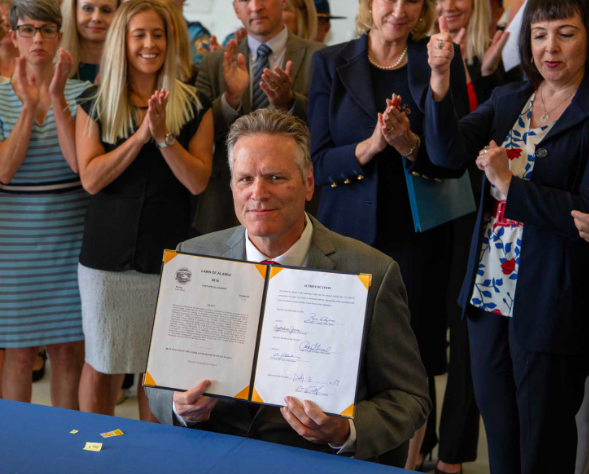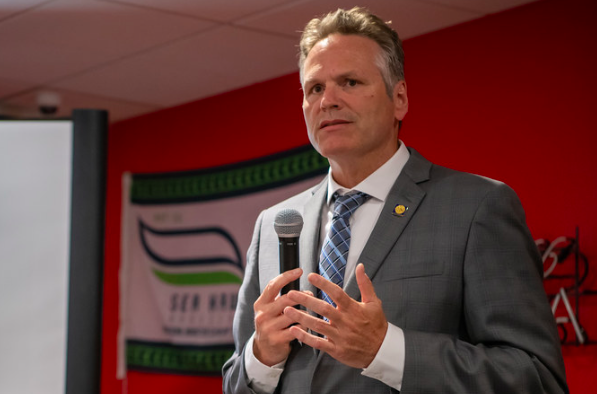By ART CHANCE
I keep waiting for the day that there is someone in the Dunleavy Administration who is ideologically and personally loyal to the governor and the agenda he ran on, and who also actually knows something about how State government works.
It is that first part that is really tough for a Republican governor. This will be long and tedious, but readers need to know it, and Gov. Michael Dunleavy especially needs to know it, now that he has been persuaded by the bureaucracy to veto HB 48, which eliminated “temporary exempt” employees and so-called “exception pay.”
[Read: Governor vetoes HB 48, which would take away his hiring authority]
First, people who actually know something about how State government should run are pretty scarce. The government grew exponentially in the late 1970s and early ’80s. A lot of people hired in those days got their jobs in the time-tested Alaska way: They conned their way into the job and tried to see how long they could keep it.
By the time I came to State government in 1987, it was pretty much a cult of personality. There was a hard kernel of experienced or well-connected people who had developed experience and authority over time and who kept things running.
Most were Salary Range 20-something, merit-system employees who were direct reports to directors or a level or two below directors. Most were in their late 30s or early 40s and had come to Alaska in the 1970s or early ’80s.
I spent my early career with a Range 22 or 23 supervisor who was a direct report to a Range 26 director. Below that Range 20-something level the vast majority of employees knew their job by rote and few knew why their job was done; they just knew that somebody told them what to do and how to do it; that somebody was usually one of those Range 20-something classified employees. Directors and commissioners came and went, but the classified service stayed on with the change of administrations.
The only consistent exception to the coming and going of directors were the administrative services directors; they seemed to have eternal life.
Everything in State government that involves money, people, and stuff rolls up to the administrative services director (ASD) of each department. They technically report to a deputy commissioner or commissioner, but it is the rarest commissioner or deputy who has the necessary subject matter expertise to effectively supervise an ASD.
Most ASDs are subject matter experts, but even if they aren’t, all the people who are subject matter experts in personnel, finance, budget, and procurement report to them. ASDs have all that expertise available to them plus historically they have been well enough known and connected to survive and be able to charmingly and convincingly lie to commissioners, to the Office of Management and Budget, to governors, and to the Legislature.
Historically, ASDs were Range 26 division directors, the same rank and range as other program division directors and all directors are subordinate to a commissioner or deputy commissioner.
However, few program directors have real expertise in personnel, procurement, budget, and finance matters and all have to rely on the administrative services director and his/her direct reports for any anything that involves money, people, or stuff. Effectively the ASD has tremendous power over most other directors and truly has no supervision other than a commissioner’s general direction.
Most commissioners and their deputies have to be shown their office and told where the light switches and restrooms are. Frankly, most commissioners are at the mercy of the ASD for the day-to-day operations of their department.
About the only thing that can remove an ASD from his/her lofty perch is getting truly cross-threaded with a commissioner, a governor, or with a powerful legislator, although they’re immune to legislators so long as the governor supports them, at least until there is a new governor.
The way to get cross-threaded with your boss is to tell him/her “no.” Yet, it is the job of the ASD and his/her direct reports to tell people “no.”
Those direct reports used to be called certifying officers, their title included the word officer, and statutorily they have real authority. A finance officer has to certify under oath that there is money for an expenditure and that it comes from an appropriation that is intended to support that expenditure.
I’m going to use old titles here because they best describe the functions. In recent years they’ve changed a lot of job titles in part to follow fashion, in part to justify salary increases, and in part to obfuscate the actual duties of the position.
It is the job of the ASD and his/her deputy, sometimes called an administrative services manager or an operations manager or something else that sounds cool, to make sure that everything a department does that involves money, people, and stuff is legal.
A personnel officer, variously called human resources manager or some similar title, must certify under oath that a hire, promotion, pay rate, or other personnel action is legal.
A procurement officer must certify under oath that a purchase has been made in accordance with applicable law.
All of these authorities come down by delegation from the commissioner of Administration through the directors of the ministerial divisions of Administration, such as Finance, Personnel, and General Services and Supply. A departmental officer can stay the hand of any one in his/her department, including the commissioner. A director of a ministerial division in the Department of Administration can stay the hand of anyone in the government, including the governor. It has been a long time since anyone has, however.
For those who remember the sad story of Gov. Frank Murkowski’s jet, it was three or four directors’ job to tell him there was no legal way to buy that jet other than getting the Legislature to appropriate the money. Instead, they all “helped” him with a work-around.
In terms of the organizational culture of the State, the Administrative Services Divisions are the maw of the beast, the State of Alaska’s version of “deep state.”
What was statutorily established as a ministerial function has become the “Work-around Division.” Saying “no” to powerful people is an impediment to having eternal life as a division director or even an assistant or deputy commissioner, positions that some of the ASDs have arrogated themselves to.
Assistant commissioner is a particularly attractive position that was created only because some long-ago director of personnel created it for somebody because it is a partially-exempt position that allows a career employee who has worked his/her way up to ASD to become an assistant commissioner at a higher salary range than director and slip the surly bonds of the statutory salary for an exempt deputy commissioner, though I think now they may have made deputies partially exempt too, so they can keep those beautiful, never ending longevity steps they got for themselves back in the Palin Administration.
While we’re on that subject, let me assure you that anybody in a politically appointed position who has made it more than one or two steps into longevity pay has at best very flexible principles, if any at all. I’ve known a few ASDs or former ASDs who made it all the way out to Step M, as high as you could go in the pre-Palin scheme as a division director. That tells you all you need to know about them.
The State’s personnel administration system has long been the land of the work-around. “Helping” a director or the commissioner to hire whomever s/he want to hire, whether or not qualified, was a surefire way to become and remain a personnel officer and it was the ASD’s job to make sure that happened.
The same was true for finance officers; the job was to figure out a way to get around the rules and laws so a director or commissioner could spend money where and how s/he wanted.
Likewise, procurement officers had to see that the “right” person or company got the contract, and not only could you get and keep the job, you might get some perks out of it — and if you were so inclined, maybe make a little money on the side.
I learned early in my career that the difference between the lifestyle of a range 20-something in a ministerial agency like Labor Relations and the lifestyle of a range 20-something out in the departments was predicated on whether or not you had procurement authority.
Some of us had “had it” with the abuses of the personnel system, which reached its nadir during the Knowles Administration. I don’t know when or even if it has really been an honest system but I believe there was a greater effort to enforce the rules and laws in the Hammond Administration and before. There was some sketchy stuff in the Sheffield Administration.
We had all sorts of problems exercising any Department of Administration or Office of the Governor authority over the departments in Cowper and Hickel. The floodgates opened in Knowles when they delegated all personnel authority and most labor relations authority out to the departments and began “streamlining” and re-engineering” finance and procurement so anybody could spend any money they wanted wherever they wanted and on whatever they wanted. Personnel and Labor Relations became so corrupt that I quit and went to work for the Legislature in 1996 rather than be a part of it.
The Knowles Administration was very successful at neutralizing or running off anybody who stood in their way, especially those troublesome classified range 20-somethings who had some clue how things were supposed to work. Along the way, Knowles’ first director of Personnel discovered that some “temporary exempt” employees appointed under AS 39.25.110(9) weren’t really temporary and were entitled to the full benefit package that permanent employees received, such as leave, health insurance, and retirement, plus they remained exempt so their job could be anything somebody wanted it to be, their qualifications could be whatever somebody wanted, and they could be paid whatever somebody was willing to pay them.
Before long everybody with a friend or lover in high places was a temporary exempt making $100,000 a year or more. The “friend with benefits” position was created by an email from the then-director of personnel to the ASDs and the department Human Resources managers. I saw the email one time back in the late 1990s; there is no record of the conferring of benefits on temporary exempts other than that email, unless they’ve come up with some policy on it since I retired, which wouldn’t obviate the fact that it is illegal.
The Knowles Administration also discovered something I’ve never found in the statutes or rules. It’s called “exception pay,” which enabled them to pay even those subject to a statutory or contractual salary more than they were legally entitled to. What made “exception pay” so convenient was that the person would show in the personnel system at a legal range and step, but they were being manually paid some other salary.
That way, if some legislator or reporter inconveniently called and asked what director so-and-so’s pretty little friend that was just hired was being paid, the State could answer that she was a Range 20, Step A – A is the initial hire step if you do it legally. If the legislator or reporter didn’t know to ask what she was actually being paid every pay period, they’d never know h/she was being paid half again more than a Salary Range 20A should be making.
Next: Where the State is today and what it means for the Dunleavy Administration.
Art Chance is a retired Director of Labor Relations for the State of Alaska, formerly of Juneau and now living in Anchorage. He is the author of the book, “Red on Blue, Establishing a Republican Governance,” available at Amazon.











